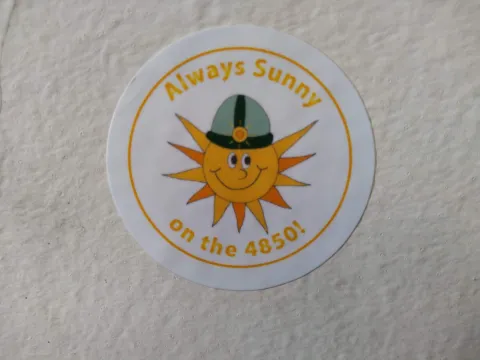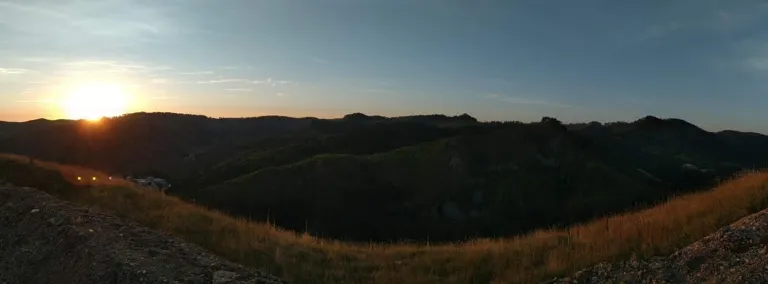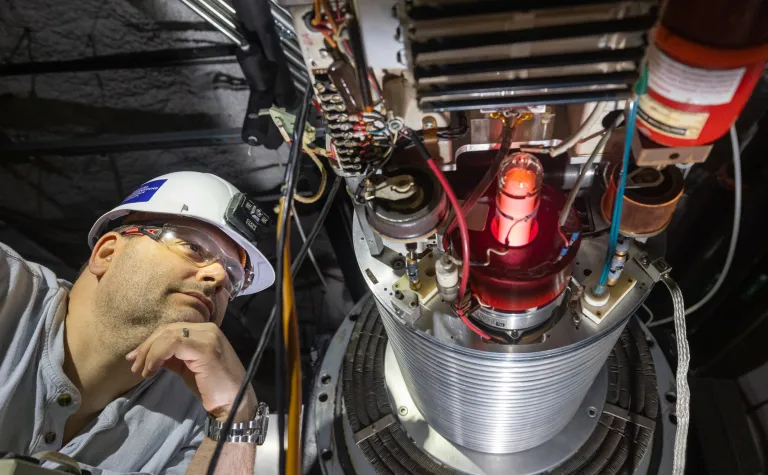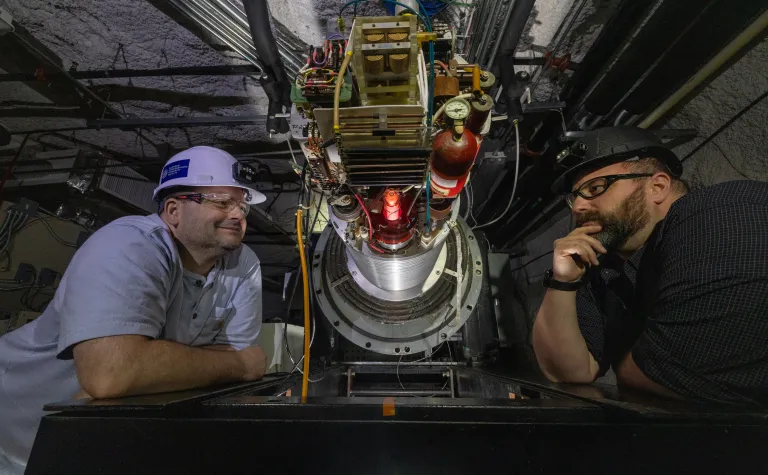A day in the life of a subterranean astronaut
As a particle physicist, I work in a unique environment: a mile underground. I’m an experiment support scientist with the Sanford Underground Research Facility.
As an experiment support scientist with the Sanford Underground Research Facility (SURF), I work in a unique environment to support the various experiments we have throughout our entire underground campus. I have a distinctive job because I don’t work on just one project, but rather on many projects helping out where I am needed. The job can be busy, sometimes overwhelming, but it’s never boring. Follow me through a typical day working nearly a mile underground at SURF.
Pulling into the lab parking lot this morning, I get to briefly watch the sunrise before I head inside. The lab, situated in the gorgeous town of Lead, SD, surrounded by the Black Hills, is at the top of one of the tallest hills in town, which offers a great view of the surrounding area.
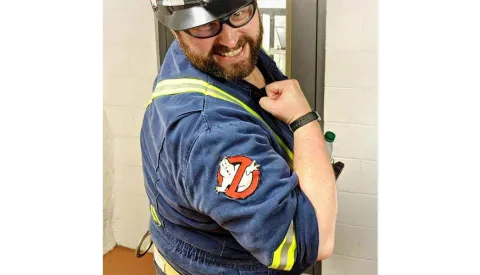
Who you gonna call?
The morning starts pretty early at SURF; I have to be ready, dressed in my safety gear and at the “cage” by 7 a.m. to go underground. My safety gear consists of steel-toed boots, a hard hat with a cap lamp, safety glasses and coveralls with safety reflectors—the coveralls make me more visible and protect my clothes from mine dust and dirt that I don’t want to track into the lab. (My coveralls sport a Ghostbusters patch on each arm because if there’s one thing I know, it’s fashion). I also carry a W-65 self-rescuer on my belt, a device capable of filtering carbon monoxide out of the air to allow me to breathe if I ever need to escape in the unlikely event of an underground fire.

Not ominous at all...
I head down an underground walkway to catch the cage. At the end of the walkway, I take two brass tags with my name on them from the orange tag board labeled “Science." I put one on a large blue tag board labeled “In” and the other one in my pocket. This is just one way we keep track of everyone who is underground at any given moment.
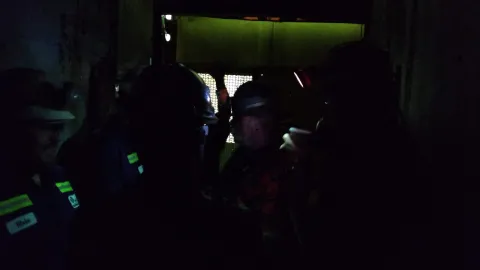
The morning cage ride
The cage ride is just like a party except that there’s no music, no drinks and no dancing. I ride the cage down with a handful of other scientists and several members of our Underground Maintenance Crew who work to keep the underground lab spaces habitable by bolting the rock, clearing the ventilation paths and maintaining all of the infrastructure. The 12-minute ride is dark, illuminated only by a couple cap lamps. It can sometimes be noisy and wet as water in the shaft above us drips into the cage. But it’s a great chance to catch up with the crews, find out what’s going on for the day and share a few laughs before the work begins.
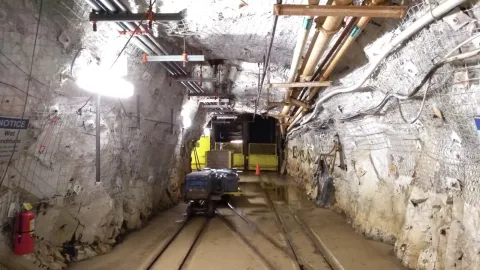
The 4850L station
It’s a full day underground; five research groups will be present on the 4850L and another one will be on the 4100L. After finishing the morning coordination discussions, I catch a ride on an underground, battery-powered locomotive to one of the two major science campuses on this level, the Ross Campus.

Motor here, motor there
I’ve been told that if you can get one of these babies to 88 mph, it will travel through time. Unfortunately, they top out at about 4 mph.
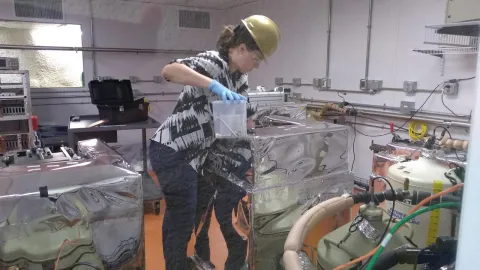
Swapping samples
A researcher swaps a sample in a low-background counter
Training done, I walk over to the Black Hills State University Underground Campus (BHUC) to help one of the researchers get together the materials she needs to swap out a radiation counting sample in one of the many low-background high-purity germanium (HPGe) detectors in that area.
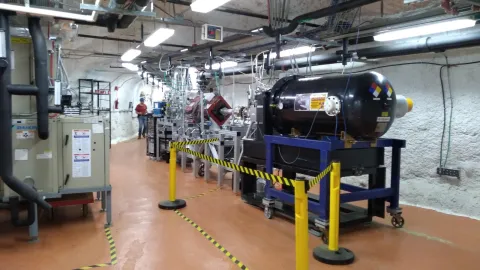
Subterranean astronauts
Anything with that much caution tape has to be fun!
I spend more time working with CASPAR than the other experiments because, in addition to being an experiment support scientist at SURF, I’m also a Ph.D. candidate at the South Dakota School of Mines & Technology (SD Mines) and CASPAR is my project. In CASPAR, an experiment in the field of nuclear astrophysics, we use a low-energy particle accelerator to reproduce the conditions inside the heart of a star, creating fusion reactions and observing the resultant particles. We do so in an attempt to better understand how the stars synthesize new elements in the cosmos. The juxtaposition of going underground to study the stars is why I sometimes refer to this group as Subterranean Astronauts.
While in CASPAR I help replace an accelerator target and review the radioactive sources (used for detector calibration) as part of our regular inventory program.
After leaving CASPAR, I walk roughly 1 km back to the other major science campus on the 4850L, the Davis Campus, which is named for Ray Davis Jr, a chemist from Brookhaven National Laboratory. Davis conducted the Homestake Solar Neutrino Experiment, detecting neutrinos from the sun for the first time in the 1960’s-1980’s. His work introduced the world to the Solar Neutrino Problem, which puzzled physicists for many years, but resulted in a share of the 2002 Nobel Prize in Physics when two other underground laboratories discovered that neutrinos come in three flavors. His work was conducted in the same space underground that is used for experiments looking for dark matter.
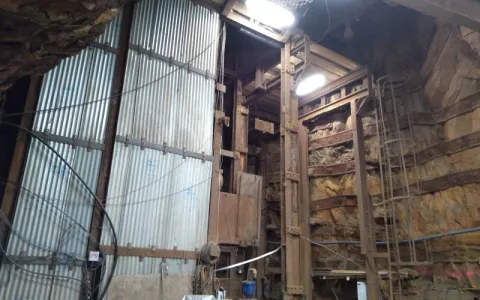
Back to the Davis
On my way to the Davis Campus, I pass by the #6 Winze, a shaft that goes from the 4550L down to the 8000L. The winze (which means a shaft that does not open to the surface) was used when the Homestake Gold Mine operated. The mine shut down around 2002. The 8000L is intentionally no longer accessible due to water that has been allowed to inflow all the way up to the 5700L.
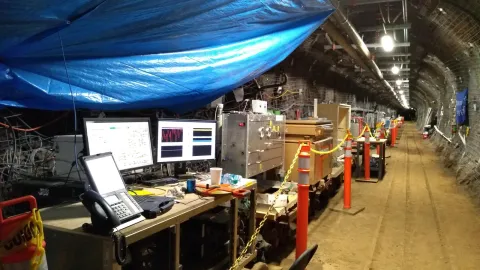
SIGMA-V wins the prize for “Experiment Most Resembling a James Bond Villain Lair.”
My trip takes me down the West Drift, so I am able to check on the SIGMA-V equipment. SIGMA-V is an experiment being conducted to help understand processes that can be used to improve the efficiency and feasibility of geothermal energy production. In contrast to most of the drifts underground, this area is well lit to help the researchers on that project work quickly and safely.
The area beyond SIGMA-V, however, is not lighted. Aside from the line of overhead reflectors indicating my primary escape route in case of an emergency, there’s not much to capture on camera. I have to use my cap lamp to see where I’m going as I hike the remainder of the way to the Davis Campus. This area is quiet and it can be very peaceful to walk through alone—my monastery a mile underground.

.
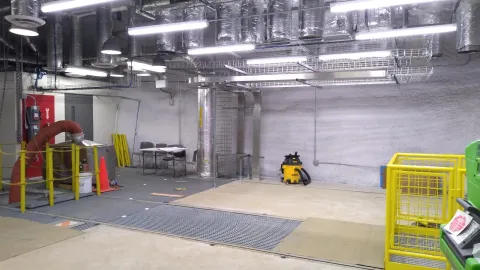
Future's so bright ...
LZ’s future is so bright, I gotta wear shades. No, seriously, it’s really bright in here.
SURF is in the process of upgrading the space once occupied by the LUX (Large Underground Xenon) experiment so it can fit the second-generation dark matter search experiment, LUX-ZEPLIN. The construction is nearly complete and today’s activities include installation of circulation lines and chemical passivation of the seams of the massive water tank that will be used as active shielding for the LZ detector. I check in with the researchers working on those two tasks, do a quick inspection of the lab spaces then head back out to wash my boots one more time before going into the Davis Campus clean space.
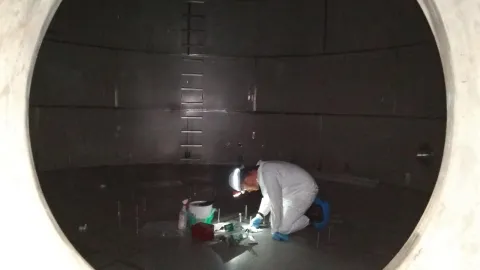
Entering the clean space
Not to be outdone by Michelangelo, this LZ engineer paints a fresco on the water tank floor.
To enter the clean space, I must wash my boots one more time, take off my dirty hard hat and rescue belt, then gratefully remove my coveralls (which have acted like a personal sauna until now). I walk through a maze of doors that act as airlocks to keep out dirt and dust and I pick up a clean hard hat and clean lab shoes before entering the Davis Campus clean space. The two major experiments housed at the Davis Campus require exemplary cleanliness and we go through great efforts to meet those requirements. One of those experiments is LZ, but because it is under construction and separated from the rest of the Davis Campus by a plastic barrier, the most stringent cleanliness protocols do not apply right now. (They will be reinstated once construction is completed and a deep clean can be performed).
The other experiment, the Majorana Demonstrator, aiding in the search for neutrinoless double-beta decay, is currently running and is very sensitive to any outside contaminant. Researchers working directly on Majorana must go through a second, even more stringent set of cleanliness protocols—they wear a hair net, booties over their lab shoes, two pairs of nitrile gloves, a Tyvek suit, a hood, a face mask, another pair of booties that clip into the suit, and tape around the gloves at the sleeve. (When I have helped out in Majorana, it is usually at this point that I realize I need to use the restroom.) Onced garbed up in this fashion, researchers can enter the detector room where they must discard their topmost pair of nitrile gloves and put on a new pair.
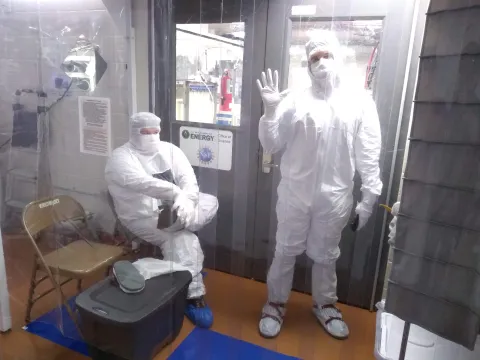
A natural habitat for an underground physicist
Inside the Davis Campus I check on the facility monitoring computer, do a quick update and wipe down one of the stainless steel tables. At this point I can finally sit down, pull out my laptop and begin logging the daily lab activities. I also need to complete the training paperwork from this morning’s training session, send some emails about safety inspections and distribute notes from a meeting the day prior.
When it’s time for lunch I take a break from the computer work and read a nuclear astrophysics paper for my Ph.D. research, while I eat. No rest for the wicked(ly handsome). Then a few of the researchers join me for a 1 p.m. phone meeting wherein all of the science groups talk about their upcoming plans so we can coordinate efforts and make sure we have everything we need in place. After a busy morning, the rest of the day goes by quietly. I get a few calls from researchers needing me to coordinate resources and find transportation f
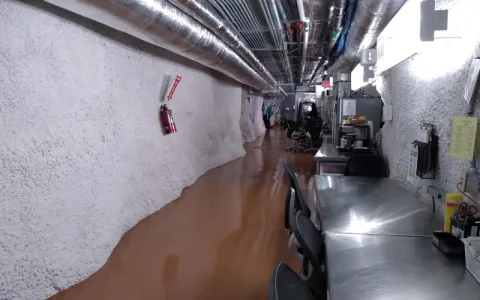
Back to the surface
The afternoon cage is like the morning cage, but in reverse and more exhausted.
Before I know it, it’s time to pack up and get ready for the ride to the surface. The cage up is a bit more crowded than the cage down. We shuffle in and take the 12 minute ride to the surface world, joking and talking through what needs to get done tomorrow.
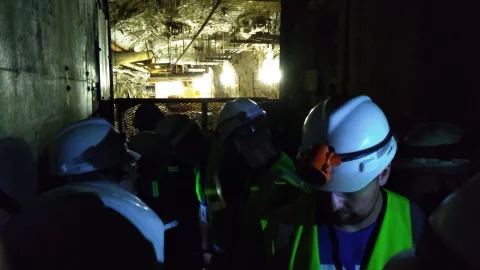

The Sun! It burns!
It’s a sunny day on the surface and it’s good to get above ground after a long day.
But I’m looking forward to getting back to it tomorrow because, as we say at Sanford Lab, it’s always sunny on the 4850.
